Sorghum Flour Sourdough Bread – Gluten Free & Vegan
This simple Sorghum Flour Sourdough Bread is free from the top 10 allergens and is absolutely delicious! Need to make it rice free too? No problem! Just try out one of the substitutions for white rice flour suggested in the recipe and voila!


CONTENTS
3. Materials List
The essentials you need to bake gluten free sorghum flour sourdough bread.
4. FREE Baking Timeline
You’ll love how easy making this bread becomes with my FREE BAKING TIMELINE & follow-along videos. Please contact me in the comments below or on my contact page if you have any questions at all. I believe we are a community, lets help one another in our gluten free sourdough journeys!
5. Lets BAKE: 7-Steps to Gluten Free Sourdough Bread
- REACTIVATE & REPLENISH STARTER
- MIX LEAVEN
- MIX SOAKER & GEL
- ADD STARCHES & MIX DOUGH
- SHAPE & CHILL DOUGH
- PROOF DOUGH
- SCORE & BAKE
7. Frequently Asked Questions (FAQ)
Can’t find the answer to your question? Please feel free to contact me anytime in the comments below or privately on my contact page.


Want more delicious recipes at your fingertips?
Get updates on our latest posts & recipes from TurmericMeCrazy straight to your inbox!
Still don’t have a gluten free sourdough starter? No worries! I’ve got you covered! Just go to my intuitive guide to making a gluten free sourdough starter & start making yours from scratch today!
By clicking subscribe you are consenting to receive emails from TurmericMeCrazy. I will only email you monthly with new recipes & updates. No spam I promise!
INGREDIENTS IN SORGHUM FLOUR SOURDOUGH BREAD
4 COMPONENTS OF SORGHUM FLOUR SOURDOUGH BREAD
- LEAVEN – created with our active starter
- SOAKER – mixture of whole grains & liquid
- GEL – binder & liquid
- STARCHES – mixture of starches OR just one
1. LEAVEN INGREDIENTS
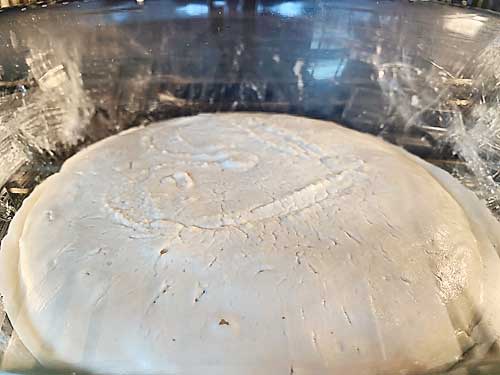
What is a LEAVEN?
After its been reactivated & has peaked, the STARTER is used to create a LEAVEN. The LEAVEN (aka preferment or active starter) is an active starter that has been kept at room temperature & freshly fed to reach peak activity and is used to LEAVEN your bake! See below for more details.
What's in the LEAVEN?
This can be either starter that has been maintained in the refrigerator or starter that has been regularly fed at room temperature. As long as the starter is healthy, vital and active! The sourdough starter is the biological leavening agent in this recipe and will give your gluten free sourdough bread a lovely rise and fluffy texture! If you don’t have a starter yet and would love to make one, please check out my follow along video guide that will make creating a gluten free sourdough starter easy for you!
Make sure the water is either filtered or tap water that has sat on the counter for at least 24 hours.
The most ideal Water temperature to promote yeast activity is between 105-115°F (40.6-46.1°C). In fact, yeast dies at 130-140°F. So if you place your sourdough starter in water >140°F the yeast will be killed off and your dough will not rise properly. Inversely, yeast in water <100°F will create a very sticky dough that will not rise as well either. It is totally worth investing in a kitchen thermometer for this purpose. If your room temperature water is very cold, simply give it a quick warm up!
Sorghum Flour (aka Jowar Flour) is unrelated to wheat and totally gluten free! It has a mild taste & smooth texture making it an excellent flour for breads. Sorghum flour originated in Africa and is still used in Indian & African cooking such as Jowar Roti (flat breads made with Sorghum Flour). I buy my Sorghum Flour at Blush Lane Organics in Calgary, but you can also find it at most grocery stores in the organic/natural foods aisle.
Jowar Flour can be found at Indian Grocery stores.
SUBSTITUTES: If you can’t consume sorghum, you may substitute 1:1 with:
- Buckwheat Flour
- Oat Flour
- Amaranth
- Teff Flour
2. SOAKER INGREDIENTS

What is a SOAKER?
Used to allow grains to absorb some of the water before the dough is mixed. It is basically an AUTOLYSE. “Auto” means something that happens all on its own, and “-lyse” means to break something down. During this soaker period, the proteins in the whole grains are broken down into smaller segments due to the natural enzymes & microorganisms present on the flour. We “SOAK” the whole grains before we add the starches. Starches are VERY water absorbent so if you don’t make a soaker, the starch will absorb so much water that the whole grains will not get a chance to break down as much!
What's in the SOAKER?
- Sorghum Flour
- Cassava Flour
- made by grating & drying the cassava aka yucca plant root (a tuber vegetable).
- includes the whole root vs tapioca flour (aka starch) which is made with just the starchy part of the plant.
- high in dietary fibre & resistant starch.
- high in Vitamin C & very water absorbent.
- White Rice Flour
- I include the white rice flour in my soaker although it is not a whole grain.
You can find Sorghum Flour, Cassava Flour & White Rice Flour at most grocers and health stores (e.g. Blush Lane Organics & Community Health Foods in Calgary).
Make sure the water is either filtered or tap water that has sat on the counter for at least 24 hours.
The most ideal Water temperature to promote yeast activity is between 105-115°F (40.6-46.1°C). In fact, yeast dies at 130-140°F. So if you place your sourdough starter in water >140°F the yeast will be killed off and your dough will not rise properly. Inversely, yeast in water <100°F will create a very sticky dough that will not rise as well either. It is totally worth investing in a kitchen thermometer for this purpose. If your room temperature water is very cold, simply give it a quick warm up!
3. GEL INGREDIENTS

What is a GEL?
Unfortunately, it is the gluten proteins in regular sourdough that bind the ingredients together. Since our gluten free flours don’t contain gluten, we need to figure out another way to bind the ingredients. Using some very healthy binders found in nature we can do just that!
I also add some enrichment to this dough by increasing the fat content slightly with olive oil. If you don’t like this you can try omitting the oil and substituting more water.
Adding a few key ingredients: apple cider vinegar, pure maple syrup, and aquafaba, help to rise the dough and bind it together. See below for more!
What's in the GEL?
Psyllium Husk is very rich in fibre & is incredibly good for the intestinal tract. In fact, it enhances the digestive process, can help improve & prevent constipation and haemorrhoid pain & has prebiotic effects. Research is even showing it can help manage diabetes and may even lower risk of developing diabetes! On top of all of that psyllium husk is heart healthy, may help decrease blood pressure, decrease cholesterol & can help with weight management. It contains antibacterial compounds that help eliminate toxins in the body & in turn give you healthy glowing skin! You can find whole psyllium husk at most grocers and health stores (e.g. Blush Lane Organics & Community Health Foods in Calgary).
Aquafaba = liquid from can of chickpeas.
You can either use dried chickpeas and soak them in water overnight or drain a can of chickpeas. Aquafaba acts like an egg does in baking and helps bind the ingredients together beautifully. This is an optional ingredient and will make your loaf much fluffier & lighter. If you don’t like that texture, just omit & replace the aquafaba with the equal amount of water!
Apple Cider Vinegar is used to strengthen the dough. I like to use Bragg’s raw unfiltered Apple Cider Vinegar for its purity and flavour.
Extra Virgin Olive Oil adds moisture and a boost of heart healthy fats. My favourite is this brand which I get at Costco. Just a little oil, softens the dough & gives it a fluffier texture. This dough enrichment is optional. If you prefer your bread less fluffy, simply omit the oil & replace with more water.
Pure maple syrup is a true Canadian delicacy! It gives more food for the yeast, increasing activity and always lends an incredible flavour!
Either a nice sea salt or kosher salt lends a good flavour to the dough. We don’t add the salt to the soaker as it slows down fermentation.
4. STARCH INGREDIENTS
Why add STARCH?
Unfortunately, once again it is the gluten proteins in regular sourdough that not only combines ingredients together but also create a network of bonds that hold the CO2 gas and create the lift in the dough.
So as always, us gluten free folk need to find another way to replace that darn gluten!
Adding starches allows the dough to absorb more water which helps bind the dough. Gluten free flours are missing the moisture retention abilities that gluten containing flours have.
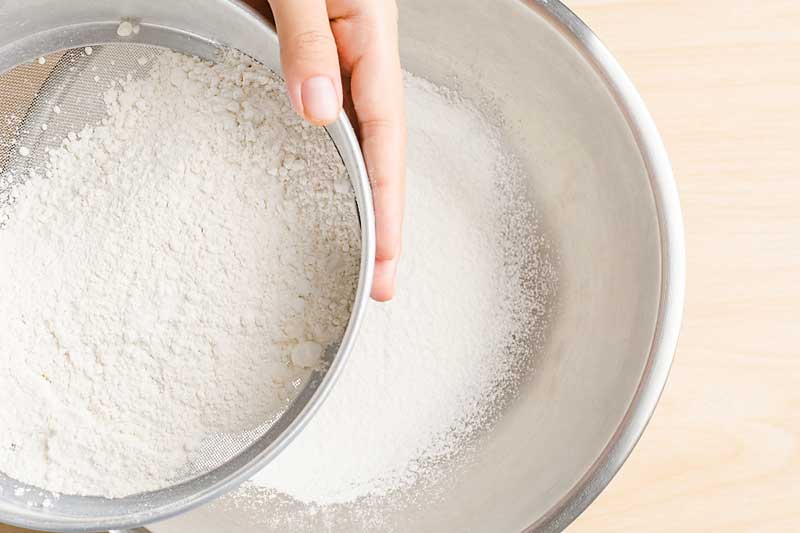
What are the STARCHES?
Potato Starch is a starchy flour that helps bind. However, Potato Starch is NOT the same thing as Potato Flour. Potato starch is a natural way to increase the moisture of the dough as potato starch absorbs and holds liquid. You can find Potato Starch at most grocery stores in the organic/natural foods aisle. I use Bob’s Red Mill.
Like other starches, Tapioca Flour (aka Tapioca starch) is a very fine white powder that comes from the pulp of the cassava plant. It is not the same thing as cassava flour, however, which is made from the entire root of the cassava plant. You can find Tapioca Flour at most grocery stores in the organic/natural foods aisle.
Can I substitute these STARCHES?
Yes! Either of these starches can be replaced by arrowroot powder if you can not consume potato or tapioca. Having more than one starch allows for a more complex flavour & better rise as each has different properties. So if you prefer, you can use a mix of a few different starches to add up to the same total weight.
MATERIALS LIST - SORGHUM FLOUR SOURDOUGH BREAD

FREE BAKING TIMELINE
You’ll love how easy making this bread becomes with my FREE BAKING TIMELINE & follow-along videos. Please contact me in the comments below or on my contact page if you have any questions at all. I believe we are a community, lets help one another in our gluten free sourdough journeys!
LET'S MAKE SORGHUM FLOUR SOURDOUGH BREAD!
If you’re like me and dearly missed either eating or baking your own sourdough, or both, you’re going to love this recipe!
7 STEP-BY-STEP INSTRUCTIONS
STEP 1: REACTIVATE & REPLENISH STARTER
(Evening before want to start sorghum flour sourdough)
STEP 1a: REACTIVATE YOUR STARTER
Tonight we will feed our starters to prepare it to make a leaven TOMORROW! You can use cold starter that has been in the refrigerator or warm starter that has been on the counter & fed daily.
Say you want to bake on Saturday for example, you will feed your starter on Friday evening. Depending on your starters environment, it will peak either overnight or the next morning. If you find your starter is slower (e.g. in a colder climate), simply increase the Starter : Feed ratio, basically keep more starter & feed it less! For instance, you could take 30g starter and feed it 75g flour & 75g water. The reverse is also true for a hot environment. Check out my Free Sorghum Flour Sourdough Baking Timeline below for more details on timing!
STARTER READINESS CHECKLIST
Follow my starter readiness checklist to decide when your sourdough starter is at its peak rise and ready to mix your leaven!
HOW TO REACTIVE STARTER - SORGHUM FLOUR SOURDOUGH
INSTRUCTIONAL VIDEO - REACTIVATE STARTER
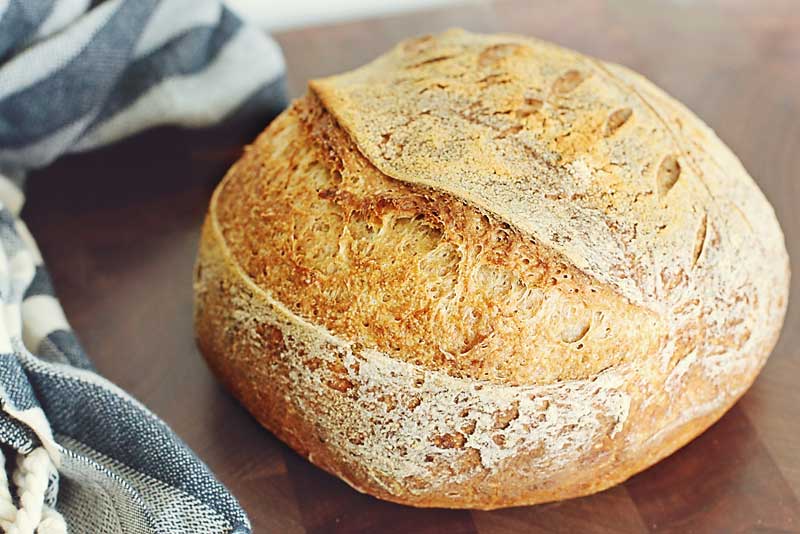
SUMMARY - REACTIVATE STARTER
* Remember if you are feeding with sorghum flour to reactivate you will need an additional 5-10g of water to achieve the right consistency (passes my “jiggle test“). You can also feed ANY type of starter as above with sorghum flour!
If you’re not having much activity in your sourdough starter, please watch the below video for more tips!
STEP 1b: REPLENISH STARTER & REFRIGERATE
(Morning of mixing day - time to refrigerate your "mother starter")
Once your starter is at its PEAK ACTIVITY, like we reviewed last night…then it’s time to mix our leaven & replenish our starters to prepare them to go into the refrigerator! If you want to bake again the following day, go ahead and keep your starter at room temperature! Putting the starter in the refrigerator slows down the fermentation significantly!
The best way to maintain your starter is in the refrigerator. I call the starter that I keep in the fridge my “Mother Starter”. When you’re planning to bake, take the mother starter out of the fridge the evening before you’d like to bake with it. Then, remove some of your starter (in this case we used 15g) & feed to reactivate it (as above). It will then be prepped & active again!
The left over “mother starter” should now be replenished (fed) prior to going back into the refrigerator. Never put your “mother starter” to bed hungry! I always “replenish, rest, refrigerate” my mother starter. After I feed it to replenish, I let it rest on the counter for about 1 hour, then refrigerate.
This is much easier than it sounds! Watch the video below to clarify! I also explain all of this in my post “HOW TO MAINTAIN YOUR SOURDOUGH STARTER“.
INSTRUCTIONAL VIDEO - REPLENISH & REFRIGERATE STARTER

SUMMARY - REPLENISH & REFRIGERATE "MOTHER STARTER"
* Remember if you are feeding with sorghum flour to reactivate you will need an additional 5-10g of water to achieve the right consistency (passes my “jiggle test“). You can also feed ANY type of starter as above with sorghum flour!
Want a healthy & vital starter?
The health & vitality of your starter will dictate the power & activity of your leaven! So, keeping your starter as strong, healthy & vital as possible is KEY!
For TIPS & TRICKS to keep your starter strong, healthy & vital, check out my post: How to Care for & Maintain a Gluten Free Sourdough Starter.
STEP 2: MIX LEAVEN (MORNING OF MIX DAY)
(LEAVEN = PREFERMENT = ACTIVE STARTER)
When this reactivated STARTER has peaked, I use it to create a LEAVEN.
The LEAVEN (aka preferment or active starter) has been kept at room temperature & freshly fed to reach peak activity and is used to LEAVEN your gluten free sourdough dough! I think of it as the “STARTER” starts off the bake & is what I keep as my constant supply. The “LEAVEN” is made when I want to bake & is used to leaven my dough.
INSTRUCTIONAL VIDEO - MIX SORGHUM FLOUR SOURDOUGH LEAVEN

TIMING YOUR BAKE
Confused about the TIMING of all of this? It’s ok! It’s a lot easier than it seems I promise! Click to grab your FREE BAKING TIMELINE!
SUMMARY - SORGHUM FLOUR SOURDOUGH LEAVEN
STEP 3: MIX SOAKER & GEL
(at same time mix your LEAVEN)
INSTRUCTIONAL VIDEO - MIX SOAKER & GEL

STEP 4: ADD STARCH & MIX DOUGH
(WHEN LEAVEN PEAKS - mix)
WHY MAKE A SAMPLE?

I love to create a little sample dough that will allow you to easily watch the progress of your dough’s fermentation.
I got this idea from Hendrik at “The Bread Code” who has lots of wonderful sourdough videos to watch. They are not gluten free, however, a lot of the principles he speaks of apply to gluten free!

BONUS, you get to eat it while it’s hot and don’t have to wait until your loaf is cool to taste it!
INSTRUCTIONAL VIDEO - ADD STARCH & MIX DOUGH

STEP 5: CHILL TIME (aka COLD FERMENT
CHILL DOUGH OVERNIGHT IN FRIDGE
It’s time to give your dough a quick shape, cover it up & let it chill out overnight!
This formula is uses a COLD FERMENT for the entire BULK FERMENTATION time. I found this process to give this dough a lovely flavour & just the perfect amount of sourness. Once you are finished mixing the dough, simply shape into a round boule, cover & place in the refrigerator overnight. Remember to SHAPE & CHILL your sample dough too!

The “CHILL” time as I like to call it is called the “cold ferment”. This is when the dough is placed into the refrigerator to develop its flavour profile. Just like when we place our starter in the refrigerator, the fermentation slows down, but doesn’t completely stop. The longer the “CHILL” time the more sour your bread will end up tasting. The “CHILL” is not a necessary step in sourdough baking and can vary from 30mins to overnight, to a few days depending on the formula. I find at least a 30min chill time just before baking, eases the “scoring” process (cut the surface of the dough before baking) and allows a slight flavour development without over fermenting your dough.
Bulk fermentation is usually done at room temperature. During this time, the dough continues to ferment, just as our starters do. This period is called the “bulk ferment” time. I like to think of it as a rest time for the dough. This is typically called the 1st rise, however, I find with this gluten free dough, I skip this room temperature rise & go straight for the CHILL time! Crazily enough, even with skipping this bulk ferment, this loaf still has that iconic sourdough flavour!
You can play around with changing the bulk ferment to include as much or as little “CHILL” time as you like! As long as you properly proof your dough (see below) after the cold ferment & it shows the below signs of being ready to bake then you’re all good!

STEP 6: PROOF THE DOUGH
(2-4 HOURS TEMPERATURE DEPENDANT)
Proofing is the dough’s final chance to rise and it happens just before you bake your dough. It is also referred to as the final rise, second rise and may others. All of these baking terms – bulk ferment, cold ferment, first & second rise, final rise, proofing etc are all referring to the science of fermentation. I go into much more detail regarding the actual science of fermentation in my How to make a Sourdough Starter Video Series if you’d like to learn more. The confusing part is that not every formula does things the same way. For example, in my Just like the REAL THING Gluten Free Sourdough formula, I use a bulk ferment, followed by a cold ferment, then a short proof & bake. This formula (aka recipe) skips the room temperature bulk ferment & instead uses an overnight cold ferment followed by a final proofing before you bake!

#1 BONUS TIP


My advice, don’t worry so much about the baking terms (unless your keen to learn that is) just follow along with each individual formula (as truly everyone & even each formula does things a little differently) and you’ll have success! As each formula is utilizing your sourdough starter cultures ability to ferment your dough and give you the iconic sourdough flavour!
STEP 6a: REMOVE DOUGH FROM FRIDGE & PROOF
(AT ROOM TEMPERATURE / OVEN WITH LIGHT / PROOFING BOX)
Now it’s time to take our dough out of the refrigerator & proof it in a warm spot. I like to place the dough in the oven with the light on for 1.5-2 hours, then remove it to room temperature to continue proofing while my oven (with the dutch oven or baking stone inside) heats up! Make sure to look for signs that your dough is finished proofing BEFORE YOU BAKE!
WATCH FOR SIGNS DOUGH IS FINISHED PROOFING!
Watch for signs proof is finished to avoid under-fermenting or over-fermenting your dough!
This is another great reason to make a sample dough! So you can keep a close eye and ensure your dough is properly proofed!
Over-fermented dough
Will lack rise, be sticky and have a gummy texture usually just above the bottom crust. Once baked, the loaf will be flat, won’t open up nicely & may have trouble browning.
under-fermented dough
Will also lack rice, have vey few gas bubbles, feel stiff, & wouldn’t have pulled away from the edges of the bowl much. Once baked, the crumb will be tight, more dense, firm & gummy as the dough was not given enough time to trap the gas as the dough fermented.

STEP 6b: CHECK PROOFING IS FINISHED


Use my proofing checkbox to help you determine when your dough is finished proofing. I go through all of these points in the video instructions below.

INSTRUCTIONAL VIDEO - PROOF DOUGH

STEP 6c: PREHEAT OVEN & REFRIGERATE DOUGH
(FOR 30-45 MINS @ 450°F = 232°C)
When you think the dough is almost finished proofing (about 1.5 – 2 hours see checkbox below), pop it into the fridge for 30 minutes while your oven preheats! Use convection bake and preheat oven to 450°F (232°C). If you don’t have a convection oven, bake at 500°F (260°C). Place your dutch oven or baking stone inside the oven to preheat.
STEP 7: SCORE & BAKE
SORGHUM FLOUR SOURDOUGH LAOF
Let’s bake our sorghum flour sourdough loaf! This is the fun part!

STEP 7a: SCORE THE DOUGH
In the video I do a simple cross hatch score but you can chose whatever score you like. I often do just a simple “C” when I’m running low on time. The importance of scoring the dough is explained in the video.
STEP 7b: BAKE THE DOUGH
- Turn oven temperature down to 425°F (218°C) convection or 450°F (232°C) if no convection.
- Bake for 35mins covered (for a nicely cooked inside).
- Uncover, turn 180°, bake 30-45 mins. Depending on how crispy & dark you like your crust.
STEP 7c: BAKE THE SAMPLE DOUGH
While your loaf is baking remember to bake your sample dough on a baking stone or small tray for about 15 mins. Remove, cool slightly & enjoy!
STEP 7d: COOL LOAF COMPLETELY
- Remove from oven & cool completely on a wire rack.
- DO NOT cut into it until it is completely cool or the loaf will be gummy inside!
- Cut your loaf once completely cool as the gluten free sourdough really needs the cooling time to set completely. I usually leave it to cool at least 3 hours or even overnight.
- NOTE: This sourdough loaf is best eaten fresh, however, when toasted it tastes delicious as well!
INSTRUCTIONAL VIDEO - SCORE & BAKE DOUGH

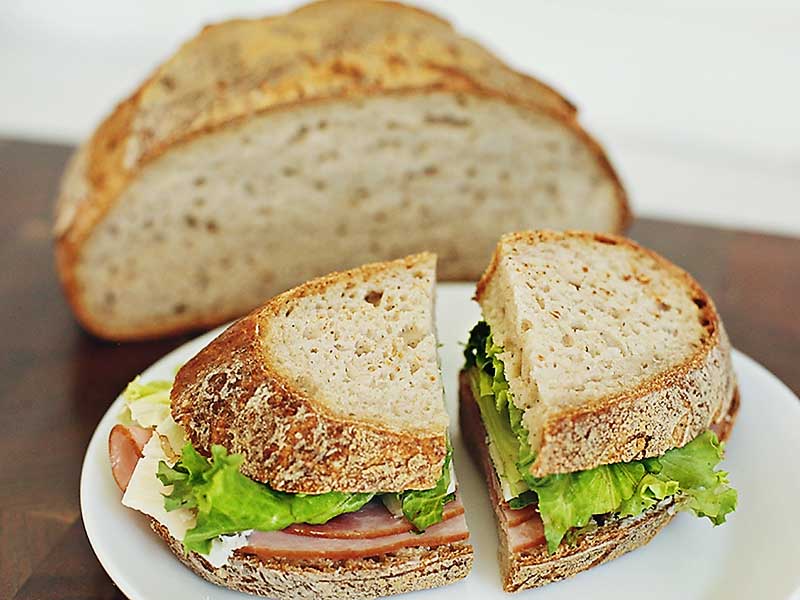
PIN THIS SORGHUM FLOUR SOURDOUGH BREAD recipe
PLEASE FOLLOW ME ON PINTEREST
Already on Pinterest? Please feel free to PIN the picture below for future reference & so others can find it too.
FREQUENTLY ASKED QUESTIONS
Can’t find the answer to your question? Please feel free to contact me anytime in the comments below or privately on my contact page.
QUESTIONS ABOUT THE LEAVEN?
Where a starter is typically fed fairly equal amounts of water & flour (100% hydration), a LEAVEN can be fed at varying levels of hydration to give the flavour complex you are looking for. Varying percentage of STARTER to FEED used to create your LEAVEN will also change the flavour profile & speed at which your LEAVEN is ready to bake.
MORE starter in the leaven
- faster speed of fermentation
- less time to peak
- more sour flavour
- more acidity due to more bacterial activity
LESS starter in the leaven
- slower speed of fermentation
- longer time to peak
- milder flavour (less sourness)
- less bacterial activity (less acidity)
How much time do you have? How sour do you like your bread?
Leaven amounts can alter the level of SOURNESS in your dough!
The amount of LEAVEN in a formula will also determine the flavour profile & speed of fermentation of your dough! Knowing this, with a little practice, you can start figuring out the perfect amount of starter within your leaven & the perfect amount of leaven in your dough to meet your tastes & desired schedule! Don’t worry about this now…this is for later!
- MORE LEAVEN = more sour dough & faster bulk fermentation
- LESS LEAVEN = more mild sour flavour to dough & slower fermentation
Once your starter has reached its PEAK RISE, mix your leaven & let it do its magic! The time it takes for a leaven to rise and reach its peak vary. When a perfectly peaked reactivated starter is used to mix a leaven, the leaven will take a good 2-3 hours (more or less depending on the temp of the environment & how much starter is in the leaven) for the leaven to reach its PEAK and be ready to mix your dough!
- TEMPERATURE of your starters environment: WARMER = LESS TIME, COLDER = MORE TIME.
- The RATIO the starter has been fed. How has your starter been responding to the previous feeds & ratios? This will give you a hint to how long it will take your leaven to reach its peak rise. The leaven is 1/2 starter : 1/2 feed so it will reach its peak quicker than our feeds that were 1:1:1 ratio!
- What is your starters APPEARANCE? Rise? Surface appearance? Bubbles? This will help you know what phase of the life cycle your starter is at & how long it will take to peak. See my post on how to make a sourdough starter for more details.
QUESTIONS ABOUT BAKING?

Baking in a dutch oven is my preferred method to bake sourdough. However, baking on a baking stone with boiling water in an oven proof dish on bottom rack works very well too. The choice is ultimately yours.
I really do LOVE my bread sling and highly recommend getting one if you plan to bake loaves regularly. You can see it pictured in the photo above. I always use it to lower my dough into the Dutch oven. The sling is re-useable which I love and it allows me to gently lower my dough into the Dutch oven so that I don’t lose any of the precious gas bubbles! If you are not using a Dutch oven, you probably don’t need one.
My sling is this one here, which you can buy on Amazon.
I CAN'T EAT RICE - WHAT SHOULD I DO?
This recipe calls for 65g of white rice flour. You can substitute with any of the following in a 1:1 ratio:
- Millet Flour
- Cassava Flour
- Oat Flour
- Tapioca Starch
CAN I FREEZE SORGHUM FLOUR SOURDOUGH?
ABSOLUTELY! As with most sourdough bread, gluten free sourdough is best in the 1st 2 days and can be left at room temperature in a brown paper bag or wrapped in a towel. If you won’t consume it within 2 days, please do slice it up & freeze it!
NOTE: This bread, like most Gluten Free baking (and all baking for that matter) is best fresh! However, if you don’t gobble it all up in one day, simply pop it into the toaster and it will taste wonderful again!
To freeze your loaf, make sure it is fully cooled then slice and wrap each slice in either parchment or plastic wrap before placing in an airtight container and freezing. This will prevent freezer burn & should stay fresh for a good 2 weeks!
Simply take individual slices out of freezer and thaw on counter overnight. I find it best to toast them slightly to gain the best taste & texture. You can also pop them directly into the toaster from the freezer, you’ll likely need to toast it twice!
DO I REALLY NEED TO WEIGH THE INGREDIENTS?
Yes! I have learn’t through experience that weighing ingredients using a scale whilst baking is super important and will allow you to reproduce great results every time! I’ve attempted measuring out the flours by volume (e.g. cups), then double checked the weights of each. They were off by quite a lot actually! It can mean the difference between the most incredible and beautiful looking bagel, to one that quite literally flops. The density of the ingredient makes a BIG difference in the volume of the flour. A new bag of flour may be packed down tight vs an already opened one. A gram will always be a gram of flour!
A KITCHEN SCALE IS WORTH THE INVESTMENT
I use a very simple mini digital kitchen scale that I got for $19.99. Trust me it is well worth the investment! It is super easy to measure ingredients by weight. It’s WAY easier than measuring by volume (e.g. cups). To measure flour, place a bowl on the scale, press the tare button to zero your scale to the weight of the bowl, and then add your flour. Simple as that!
I sure do hope you love this sorghum flour sourdough bread recipe. If you try it, I’d be ever so grateful if you’d please add a comment & a rating onto the recipe below or at the bottom of the post ♡.
Thank you once again for your readership & support.
Now let’s get baking!


Sorghum Flour Sourdough Bread - Gluten Free & Vegan
Equipment Needed
- 1 Stand Mixer optional
- 1 Dutch Oven or Baking Stone
- 1 Banneton (6.5-8" = 16-20cm) or Soup Bowl with lint free towel
- 1 Bowl with lid or Ziplock bag fits banneton or soup bowl inside
- Parchment Paper or Bread Sling optional
- 2 Ice cubes or spray bottle with water optional
- 1 small clear container with lid optional - for the sample dough
INGREDIENTS
To REACTIVATE your starter
- 75 g Sorghum Flour to feed your starter
- 75-85 g Warm Water (tepid or slightly warm to the touch) filtered or sat on counter 24 hours
- 15 g Gluten Free Sourdough Starter can be cold or room temp
For the LEAVEN
- 150 g Active Gluten Free Sourdough Starter @ PEAK see post for details
- 75 g Sorghum Flour
- 90 g Warm Water (tepid or slightly warm to the touch) filtered or sat on counter 24 hours
For the SOAKER
- 55 g Sorghum Flour
- 50 g Cassava Flour
- 65 g White Rice Flour see notes for substitution options
- 200 g Warm Water (tepid or slightly warm to the touch) filtered or sat on counter 24 hours
For the GEL
- 100 g Aquafaba (or water - see post for details)
- 30 g Extra Virgin Olive Oil (or water - optional see post for details)
- 18 g Apple Cider Vinegar
- 16 g Pure Maple Syrup
- 9 g Kosher Salt or Sea Salt
- 20 g Psyllium Husk (whole)
For the STARCHES
- 145 g Tapioca Starch or Potato Starch aka Tapioca Flour
INSTRUCTIONS
REACTIVATE STARTER - EVENING BEFORE YOU BAKE
- Feed your gluten free starter (either cold from refrigerator or room temp) a ratio of 1:5:5. Then discard all but 20g of starter. Feed 100g brown rice flour (or sorghum flour), 100g water (105-110g if feeding sorghum flour). Ensure you keep more starter to replenish! Either set aside 10-20g of starter to replenish it now, or replenish later while you mix your leaven. See post for details.
- Leave fed starter in a warm place (near ideal temp 24°C or 75°F) until it reaches peak activity (usually 8-12 hours after feed) (see post for more details on how to tell when starter peaks).
MIX LEAVEN - when STARTER reaches PEAK activity (Next day)
- Mix peaked starter (active), water & sorghum flour until well incorporated. This is your LEAVEN (aka preferment or active starter) that will be used to leaven (rise) the dough.
- Leave leaven in a warm place (near ideal temp 24°C or 75°F) until it reaches peak activity (see post for more details on how to tell when leaven peaks). Usually this will take between 2-4 hours but can take up to 8-10 hours if starter is past it's peak activity when leaven is mixed.
MIX SOAKER & GEL
- After mixing leaven. Sift flours together & mix together all ingredients for soaker. Set aside in a warm place.
- Mix your gel. Mix all ingredients in the gel together & set aside.
ADD STARCHES & MIX DOUGH - when LEAVEN reaches PEAK activity (2-4 hours after mixing)
- Add peaked leaven, gel & sifted starches to your soaker (in the bowl of a stand mixer). Mix on low-medium for 2 mins until combined. Then increase speed to medium-high for another 5 mins until dough comes together nicely.
SHAPE DOUGH & PLACE INTO BANNETON OR BOWL
- Very lightly dust countertop with brown rice flour. Use a spatula or a bench scaper to make a dough ball & then transfer to countertop. Gently shape dough into a ball ensuring to close all seams. Remove a small piece of dough for your sample (see post & video for more details).
- Gently flip dough into banneton (dusted with rice flour) or soup bowl (no need to dust) top side down. Place banneton or bowl into an airtight container or ziplock bag.
CHILL
- CHILL your dough (aka cold ferment) covered in the refrigerator overnight.
PROOF DOUGH (NEXT MORNING OR AFTER WORK)
- Place the dough in the oven with the light on (or in a warm spot) for 1.5-2 hours, then remove it to room temperature to continue proofing while oven heats up. Watch for signs proof is finished to avoid over-fermenting your dough!
PREHAT OVEN
- Preheat oven with dutch oven or baking stone inside, to 450°F (232°C) convection setting, for 30 mins. No convection? Increase temp (475°F or 246°C) & or increase bake time slightly.
SCORE & BAKE
- Once oven has preheated for 30 mins, and dough is finished proofing (see post for checklist), use parchment paper or a silicone baking mat to gently flip dough out and onto countertop (top of loaf now facing up).
- Spray loaf with a little water (optional) then dust generously with rice flour if desired. Score loaf at a 45° angle to the surface. See video for more details. Remember to score your sample too!
- Gently lift dough into the dutch oven, cover & place on centre rack. TURN OVEN DOWN to convection 425°F (218°C) & BAKE covered for 35 mins. No convection (450°F or 232°C).
- Bake your sample dough on a baking stone or tray for about 15-20mins. Remove, cool for 5-10 mins, and enjoy!
- After 35 mins, uncover dutch oven, turn dutch oven 355°F (180°C) & bake for another 30-35 mins uncovered.
COOL THEN ENJOY
- Make sure to let your beautiful artisan loaf cool for at least 2-3 hours before cutting into it. The gluten free sourdough needs to completely cool in order to set fully.
Notes
- Stand mixer is very useful for this recipe but not essential. You can mix by hand but just make sure to mix well until ALL the ingredients are well incorporated & dough comes together nicely (10-15mins).
- This gluten free sourdough is best slightly warm. I always give mine a slight toasting and it tastes like it came directly out of the oven!
- HOW DO I MAKE THIS TOTALLY RICE FREE?
-
- Millet Flour
- Cassava Flour
- Oat Flour
- Tapioca Flour (aka Tapioca Starch)
- CAN I FREEZE MY LOAF? Absolutely! As with most sourdough bread, gluten free sourdough is best in the 1st 2 days and can be left at room temperature in a brown paper bag or wrapped in a towel. However, if you won't consume it within 2 days please do slice it up & freeze it! TO FREEZE: Once fully cooled, slice the loaf and wrap each slice in either parchment or plastic wrap before placing in an airtight container and freezing. This will prevent freezer burn & should stay fresh for a good 2 weeks or longer! TO THAW: Simply take individual slices out of freezer and thaw on counter overnight. I find it best to toast them slightly to gain the best taste & texture. You can also pop them directly into the toaster from the freezer, you'll likely need to toast it twice!
Nutrition
OTHER DELICIOUS SOURDOUGH RECIPES TO TRY...
some other recipes to try

Sorghum Flour Sourdough Bread – Gluten Free & Vegan

How to make a Fluted Pie Crust Edge

Sinful Skor Cardamom Cheesecake Recipe

The Absolute Best DIY Lip Balm with SPF (optional)

Pumpkin Spice Latte Recipe

How to Make Gluten Free Sourdough Bread!

Heat Me Up Carrot Pickle (Spicy Gajar Jo Athano)

How to make Coconut Flour at home – 2 ways!

Brown Rice Sourdough Starter: Day 14
Remember to grab your FREE Baking Timeline that will create ease for you during baking. You’ll ♥︎ how easy making this bread becomes with my FREE BAKING TIMELINE & follow-along videos. I sure hope that this helps give you some ease in your gluten free sourdough journey!




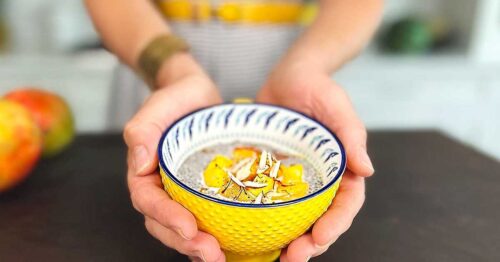
























8 Responses
I am about to mix leaven, gel, soak and starch. It’s only 11 am and you say to cold proof overnight. Do I have to cold proof that long? I was hoping to cook today
Hello Lori,
I’m sorry for my delay in responding to your question. I sure do hope that your cook worked out! You do not have to cold ferment overnight. In fact, you don’t have to cold ferment at all if you don’t want to. The cold ferment is to allow the dough to develop flavour so if you skip this the flavour profile will not be as rich. Please let me know if you have any further questions. I have flagged your message so I can hopefully get to it much sooner 🙂 If you have a more pressing question please feel free to email me at [email protected] and I’ll do my absolute best to reply in a timely manner. I hope this helps.
Hugs,
Trish
I have a question:
On the instructions for Sourdough ‘Reactivate’ instructions as listed above, the 1:5:5 of Starter, Flour & Starter listed at 20g / 100 / 110 : is different from the download ‘time-saving’ instructions to Reactivate, which also state the ratio of ingredients, as 1:5:5, but listed as 15g Starter / 75g Flour / 75g+ Water.
I’m not sure which one is accurate.
Thank you.
Hello Debra,
Thank you for the note, I am sorry for the confusion. I hope I can help clarify. Both are accurate as they both use the ratio of 1:5:5, however, feeding 15g of starter will give you exactly the amount you need for to mix your leaven and make your loaf. Feeding 20g is a general recommendation as this allows you to have some active starter to replenish and place back into the refrigerator (I call this the “mother starter”. I hope this helps!
Sincerely,
Trish
Just started making GF sourdough but wanted to use sorghum flour so that’s why I’m here.
I signed up for ‘Timing Table’, thanks for that!
I’ll let you know how it goes. I already have a starter to use.
BTW: LOVE the name of your website – brilliant and funny!!
Take good care.
Hello Debra! I am so glad you found me and thank you so much for your kind comment 💜! I’d be very happy to hear how yours turns out and please let me know if you have any questions at all! Take good care.
Hugs,
Trish
I tried this recipe today and I loved it!
Thanks so much for the comment Mike. So glad you love it!